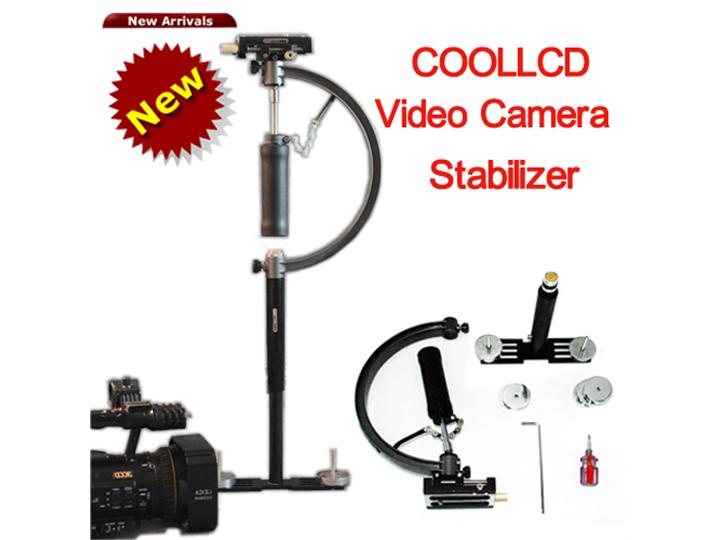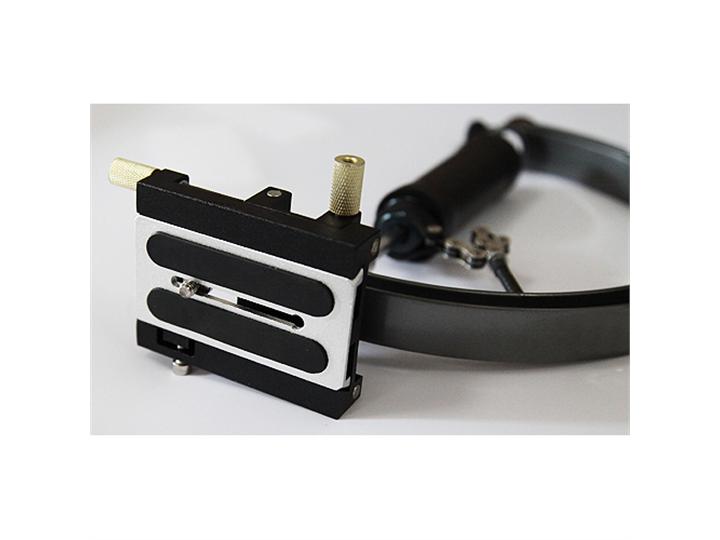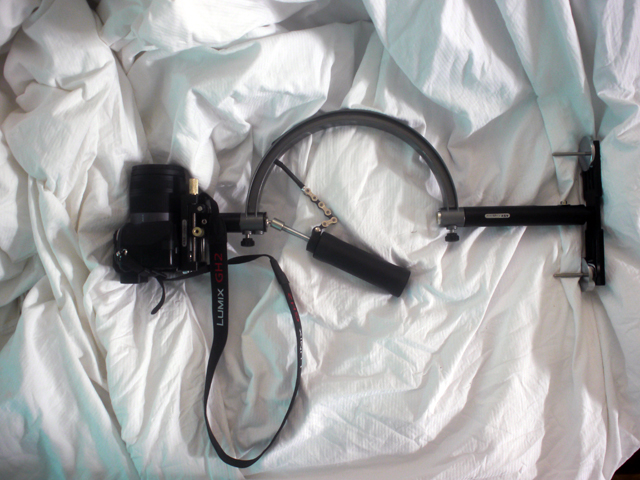
Not good Stabilizer
-


Price: -
Platform is good, adjustable.
Same for rod length.
Also weight can be shifted, this is good.
Not recommended. See below.
-
For me it looks very good, if you use hands as offset designs lead to fatique much faster .
-
Yes I am familiar with a company called BSW that makes this (or a variant). I don't think Chinese are getting much better at C&D. I know I work for a Chinese Design company and concept design here is shit ;-)
Anyway, check out this link - scroll to the bottom and you will see some more pics and links to some vids.
http://item.taobao.com/item.htm?id=4405878082& -
Thanks for all the information. I have to buy a stabilizer asap. CoolCD seems to be a good option. The other option is WONDLAN Ares.
I guess the difference in price comes to 50$. Wondlan looks more solid and easy to balance and carry more weight may be. Will CoolCD be easy to balance too?
Theres another interesting stabilizer:-
http://www.youtube.com/user/nakulembracevideo#p/u/9/at_CWdpNMns
This one has solid platform and I am told by the manufacturer easy to balance. But it seems little heavy. It costs little more than 300$.
http://www.embracevideo.com/purchasecasper.html
Most of the videos online are of the footage taken from the balanced systems. While the main concern is how easy it is to balance the rig.
Still confused, which one to choose from these three. -
Don't know any of the above stabilizers, but from my experience here's my 0.02 euro about choosing one:
1) Choose the lightest one if there's a clear choice. It's hard work operating any stabilizer for any length of time and heavy weight makes it difficult to keep it steady as you're holding it away from your body and that's difficult to do well for long. You also need ideally some sort of stand to hold it while you unmount the camera (for regular shots).
2) A stabilizer is like a musical instrument - it won't guarantee fantastic results from the get-go. You have to put in the hours. The best designs will put fewer limitations on your skill as you get better at operating it, but when you say you have to buy a stabilizer ASAP, I hope that's to allow for the practice time!
3) In my experience, the most difficult and revealing bit about stabilizers is when you change direction. So have a really careful look at any promotional videos to see what happens when you change direction - does the thing start to swing or wobble? Look particularly at footage where there are lots of horizontal and vertical lines (such as buildings and roads) and using these as reference points, pay close attention to what's happening at all four edges of the frame, as that reveals any problems with jerky panning movements or pendulum motion when changing direction. -
@manjeet
I think that it is too soon for personal expirience, wait fro @driftwood opinion if you can.
Personally, do not like Merlin style stabilizers (like Wondlan) as they behave pretty strange sometimes.
I tried on once, but may be I just not familiar with them.
Platform of CoolLCD seems ok. Ability to adjust length is plus as well as ability to slide weights a little.
As far as I remember T like bottom weigh distribution helps with camera behaviour.
Merlin type has most weight in one point. -
Just received the ASX-MOV ST-10 from CoolLCD (£160), took four days from China to UK via DHL with standard £35 shipping (quick!); packaged as a gift saving me some dosh ;-) (only £8 VAT!); Opening the box you find yourself with a fake Sony Vaio-badged laptop bag (pleasant surprise!); open the bag and all the bits in the picture are there to be found and assembled (looks fairly robust metal castings); the CD jpg'd manual is in chinese and is sooo small its unusable and is not that adequate (it doesnt take much skill to put it together :-) ); the accompanying 'how to' video (again in chinese) is for the larger video camera model setup and not for this, the 7D/HDSLR version (so I'm going to make my own for us GH2 users!); 1/ find the balance of your camera(+chosen connected lens) and find the mid weight point - mark mid-point with tape, mount quick release plate onto GH2 underside and slide into the top mount (flimsy quick release button but adequate), use the brass coloured X/Y screwable adjusters to set camera centre of mount (repeat this later to finalise camera to weight balance position), 2/ lock into place the head extender and mount it onto the top of half-hoop, mount the T weight (which has a spirit level set into its head) to the bottom of the half-hoop and tighten, 3/ begin to place weights onto the T base to counterbalance camera until you have the spirit level dead centre (of course the T bracket can be adjusted in height to further aid stability), the weights have three areas each side to attach weights to aid balance to to the camera - especially as HDSLs such as the GH2 are heavier on the battery side (so add the weights to the left and and back for the GH2!). And thats it. Two things annoy me - the two half hoop screw fixers (to the camera mount and the T base provide inadequate tightening (they supply three extra screw fixers) as they are easy to come loose sending the camera/or weights off balance; but Ill tighten up (may have to gaffer it down...) and get on with using it, Yep, the car style shock absorber system from the handle to the half-hoop seem to react well with any movement...
Well I'm nearly set.... more thoughts soon as I will be trying it out today...

 AVXST10.JPG640 x 480 - 300K
AVXST10.JPG640 x 480 - 300K -
-
@driftwood Thanks for the inputs!
Hope the system is not a burden on hands and sets up quickly with good balance. -
@driftwood, are there any red flags for the CoolLcd stabilizer? Sorry for bothering you...I have to start the shoot by 9th of this month.
-
Dreadful. The pivot is way too far below the camera platform. This means that the counterweight has to be that much further away and/or massive than it would have to be, and so the entire unit is then larger and/or heavier than it has to be. Really basic physics, people!
And what's with the bike chain? If you want the pan axis to be locked to the grip instead of being free to turn, just use a universal joint for the main pivot, not a ball-joint. Ball joints have way too much friction anyway.
I see the the auction listing addresses the crucial question of its operation on stairs. Very important, since we all know that stabilizers must be tested on stairs. No mention of how it performs in front of a mirror, however. :) -
>The pivot is way too far below the camera platform. This means that the counterweight has to be that much further away and/or massive than it would have to be, and so the entire unit is then larger and/or heavier than it has to be. Really basic physics, people!
And?
This thing is longer.
And longer steadicam with bigger weight will be always more stable in skilled hands. Same physics. -
VK,
Agreed that is why with smaller/lighter camera many have to add weight or move them up away from the platform to get stability.
Never seen a tightrope walker with a three foot long pole. Usually around twenty feet, same principle, more stability. Same physics! -
@manjeet Gotta say this is pretty flimsy at the screw connectors to half-hoop. Subsequently, it moves around all too easy. Also my X/Y axis screws were so tight that they couldn't move up 100% (which is required to move the weight of the camera over to the left because the gh2 is top heavy right-hand battery side). It is near on impossible to get perfect central weight distribuition. When you think you have it all centre and weighted correctly, it just goes out of balance! Its about 75% reliable. One-handed forget it. The chain is rendered useless by the poor screw fixings. If you counter hold it at the top with you other hand its not too bad - but thats going against the purpose in a way!
I think (like Butt said) a monopod is just as good to use when compared with this on a small camera with say a 14-140 lens like the one I tried out here... I'm in two minds whether to ask for a refund or ask for replacements parts. Either way you're going to have to gaffer tape the half-hoop to the camera head and T bracket... its that bad!
On the other hand the suspension system does work but I cant help but think that this was designed for a heavier video rig....
Summary: Its not ideal. Bring on the next one. -
@driftwood Thanks for saving me from the headache. Again I am stuck with what to buy question:(
-
Can you hire one so you can get going quicker (if there's one near you)? Or spend a lot of dosh on a good one then sell again after your project? You need to allow at least 6-8 hours to even get used to the basics of moving with one and you said your shoot is coming up soon...
Start New Topic


Howdy, Stranger!
It looks like you're new here. If you want to get involved, click one of these buttons!
Categories
- Topics List24,043
- Blog5,725
- General and News1,377
- Hacks and Patches1,153
- ↳ Top Settings33
- ↳ Beginners256
- ↳ Archives402
- ↳ Hacks News and Development56
- Cameras2,384
- ↳ Panasonic995
- ↳ Canon118
- ↳ Sony156
- ↳ Nikon96
- ↳ Pentax and Samsung70
- ↳ Olympus and Fujifilm102
- ↳ Compacts and Camcorders300
- ↳ Smartphones for video97
- ↳ Pro Video Cameras191
- ↳ BlackMagic and other raw cameras132
- Skill1,960
- ↳ Business and distribution66
- ↳ Preparation, scripts and legal38
- ↳ Art149
- ↳ Import, Convert, Exporting291
- ↳ Editors191
- ↳ Effects and stunts115
- ↳ Color grading197
- ↳ Sound and Music280
- ↳ Lighting96
- ↳ Software and storage tips266
- Gear5,420
- ↳ Filters, Adapters, Matte boxes344
- ↳ Lenses1,582
- ↳ Follow focus and gears93
- ↳ Sound499
- ↳ Lighting gear314
- ↳ Camera movement230
- ↳ Gimbals and copters302
- ↳ Rigs and related stuff273
- ↳ Power solutions83
- ↳ Monitors and viewfinders340
- ↳ Tripods and fluid heads139
- ↳ Storage286
- ↳ Computers and studio gear560
- ↳ VR and 3D248
- Showcase1,859
- Marketplace2,834
- Offtopic1,331










